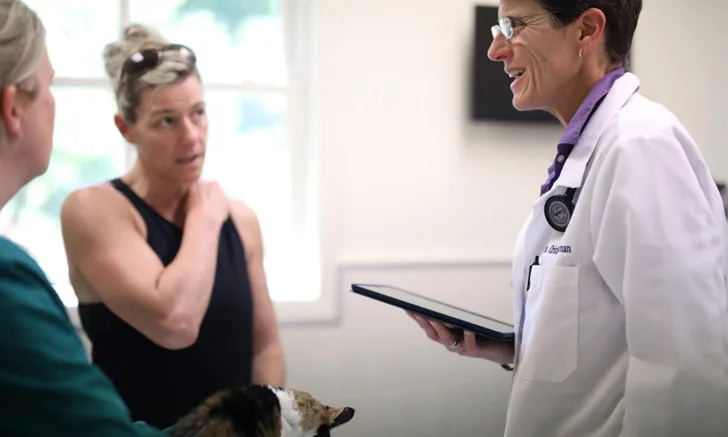How to Create an Effective Veterinary Exam Room
Kara M. Burns, MS, MEd, LVT, VTS (Nutrition), Olathe, Kansas

A version of this article originally appeared in the January/February 2015 issue of Veterinary Team Brief.
Veterinary healthcare teams see the majority of their patients in the examination room. But what does it take to make an examination room truly effective? How does the team create an experience for patients and clients so that both receive the best care in comfortable, private surroundings?
In most practices, clients and patients are first greeted by the receptionist(s) and then escorted to an examination room. What happens next?
Clients are members of their pet’s healthcare team, and the relationship among all team members is based upon working in the patient’s best interest. As the client and veterinary team member enter the examination room, the team member should be asking for a brief history of the reason for the visit, immediately showing that concern for the patient is paramount to strengthening the bond between the client and the veterinary team.
The Vital 5
First, every patient should be evaluated for these 5 vital signs at every practice visit:
Temperature
Pulse
Respiration
Pain
Nutrition
Communicating with the Pet Owner: Get the Full Story
The veterinary team member should then take the patient’s complete medical history, including any history from the patient’s previous veterinary practices. As this information is recorded, the patient’s presenting complaint should not sidetrack the team member. The medical history should include the patient’s:
Allergies
Current medications
Dental health
Environment, including where the patient lives (indoors vs outdoors), other household pets, exposure to other animals, and travel
History of parasite control
Nutritional history
Previous Body Condition Score (BCS)
Previous medical conditions (eg, GI issues, respiratory or urinary diseases, lameness, masses, trauma, surgeries)
Typical temperament and any unusual behaviors
Vaccination history, including where specific vaccinations were administered on the body
Weight
The Veterinary Physical Examination
Next, it is the veterinarian’s turn to perform a hands-on physical examination from nose to tail:
Visually study the patient for conditions such as lameness or poor breathing patterns
Physically examine the patient’s body, including checking his or her eyes and ears, determining a BCS, and feeling for lumps or bumps
Auscultate the patient’s heart, lungs, and abdomen
Opportunities to Improve the Vet Exam Experience
The examination room is the ideal place for veterinary technicians to educate clients, so it should be a safe environment where clients feel free to ask questions and discuss the answers. Clients with adult pets should be educated about heartworm prevention, flea and tick disease and prevention, nutrition, and dental disease prevention. Puppy and kitten owners should be educated about these same conditions, as well as vaccination schedules.
To ensure the examination room is a safe, non-threatening, non-stressful environment for the client, the patient, and the veterinary team:
Do:
Ask the client’s permission before performing the examination.
Ensure the room is clearly marked as an examination room and flagged when occupied.
Provide a clean, sterile environment secluded from distractions from other clients and patients.
Consider providing such things as magazines, toys, and water bowls for clients and patients while they wait.
Ensure that all the needed equipment is ready:
Clean, easy-to-reach stethoscope
Clock with a second hand
Nutritional history form
Otoscope and/or ophthalmoscope
Pain-scoring protocol sheets for each species
Specimen-collection containers
Sterile gloves
Sterile thermometer.
Have on hand appropriate literature and anatomy models that will help the client understand, especially when discussing the patient’s parasites, disease conditions, or nutritional recommendations.
Document every finding and topic of discussion in the medical record (either paper or electronic).
Provide estimates when appropriate.
Consider whether the patient can be treated in the examination room or whether a treatment room would be more comfortable.
Consider creating a comfort area for stressed clients and patients.
Ask for assistance from the healthcare team if the patient needs to be restrained to allow for a better examination.
Know the patient’s name and gender and always demonstrate affection toward him or her.
Do Not:
Take a client into a room that has not been cleaned and/or sterilized after the previous patient, which appears unprofessional and implies that the patient is not important.
Leave the door open, unless the client requests it. Clients may want privacy when talking about their pet and any potential problems.
Ask closed-ended questions, because they signal that the team is trying to rush the visit. Instead, ask clear, open-ended questions such as What questions do you have regarding the examination so far? that show understanding and empathy.
Provide too much information at once. Handouts and concise discussions help with understanding, but “information overload” will make clients tune out.
Assume the client is willing to wait a long time if you are running late. Check if he or she would prefer to leave the pet or reschedule.
The examination room is a private area where clients and patients interact with veterinary team members one-on-one. A room that is clean and quiet and an examination process that is efficient and thorough will give clients confidence that their pet is in the hands of a caring, knowledgeable veterinary practice and healthcare team.